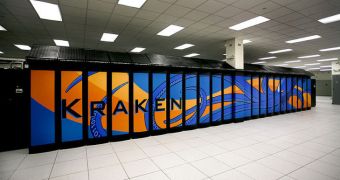The Kraken Cray XT5 supercomputer at the National Institute for Computational Sciences (NICS) has recently been upgraded to become the first academic computer in the world to exceed one petaflop of calculation power. The acronym FLOPS stands for FLoating point Operations Per Second, and the Kraken is now able to perform about a thousand trillion mathematical calculations per second. The upgrade also places it within the top five supercomputers in the entire world, alongside petaflop-scale giants such as IBM's Roadrunner and the Cray XT5 Jaguar.
“At over a petaflop of peak computing power, and the ability to routinely run full machine jobs, Kraken will dominate large-scale NSF computing in the near future. Its unprecedented computational capability and total available memory will allow academic users to treat problems that were previously inaccessible,” Phil Andrews, the project director at the NICS, says of the improvements. The Institute keeps its computers at the Oak Ridge National Laboratory (ORNL), which is the most powerful supercomputer complex in the world to date. NICS is funded by the US National Science Foundation (NSF), and is managed by the University of Tennessee.
The new and improved Kraken features 16,000 six-core 2.6-GHz AMD Istanbul processors, for a grand total of nearly 100,000 cores. When it was brought online on October 5, it recorded a peak computational power of 1.03 petaflops, its managers said. It now features 129 terabytes of memory, or the equivalent of 13,000 movies on DVD, which means that it can run some of the most sophisticated, 3D, scientific computing applications ever developed. It will be used for materials science studies, as well as for modeling global warming and the events inside stars and supernovas.
“While reaching the petascale is a remarkable achievement in itself, the real strides will be made in the new science that petascale computing will enable. Kraken is a game changer for research,” NICS principal investigator Thomas Zacharia adds. He is also a professor in electrical and computer engineering at the University of Tennessee, and the Oak Ridge National Laboratory deputy director for science and technology. The improvements to the supercomputer were made possible through an NSF Track 2 award to the University of Tennessee, in excess of $65 million.

 14 DAY TRIAL //
14 DAY TRIAL //